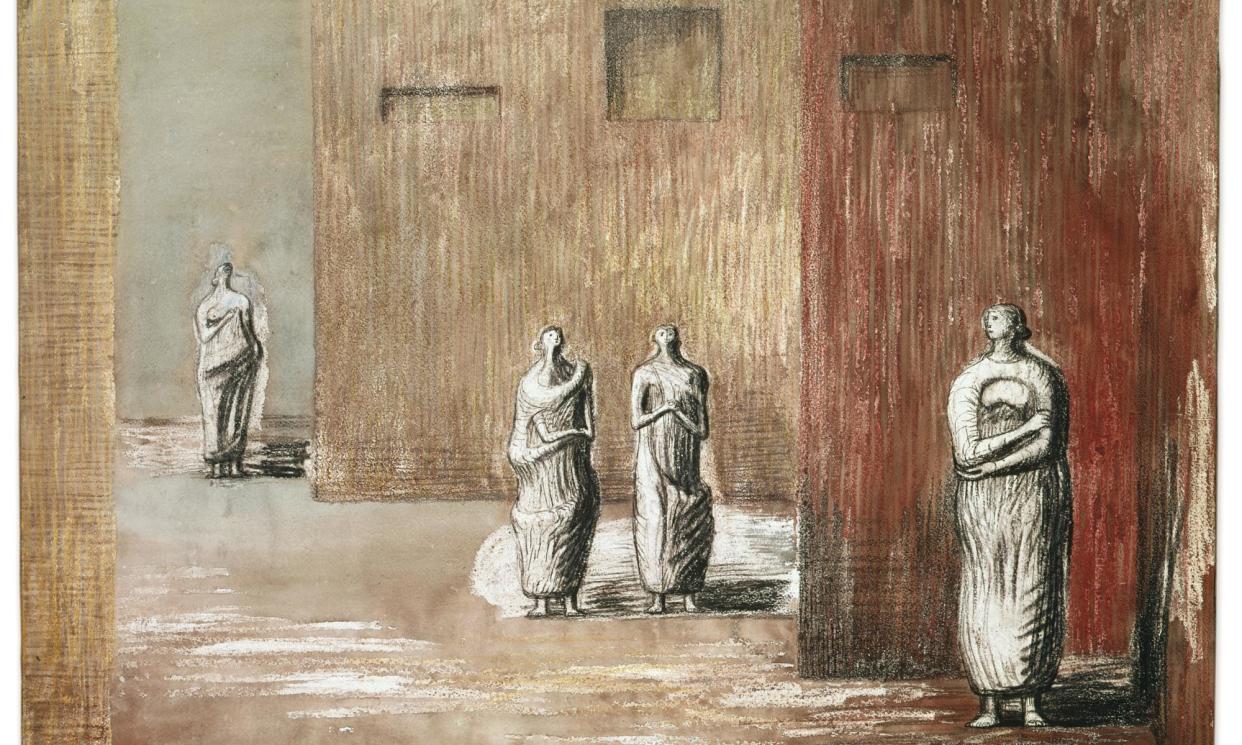No perky cockneys? How Henry Moore’s sheltering souls puncture our blitz bravado

When the blitz began in September 1940, Londoners sought the safety of deep Underground stations and tunnels – and Henry Moore, the most famous British modern artist of the age, went down there to sketch them. His eerie drawings of people neatly lying in rows or sitting haggard in vortex-like ashen tunnels are startling and disorienting because they don’t bear any resemblance to our myths about the second world war.
Where are the perky cockneys defying the Nazi bombs? These people burrowing into the earth to survive look desperate rather than indomitable. The works don’t even look very British: instead of dwelling on quirky details of Underground posters or clothing that would localise them, Moore abstracts his sheltering souls. The drawings seem to embody suffering across all of 1940s Europe.
The images – in pencil, crayon and watercolour – are showing at the Courtauld in London and it’s a timely outing, for they have much to show us about British patriotism, the second world war, the Labour election victory of 1945 – and why it looks like being matched or even exceeded in July.
Of course, the British survived and, as the 80th anniversary of D-day has reminded everyone, shared in a famous victory. They then promptly voted wartime leader Winston Churchill out. The 1945 election left Churchill’s Conservatives with just 197 seats in the Commons, to Labour’s 393 – the biggest ever Labour landslide. So far. The right loves to dwell on Britain’s wartime courage, held up as an ideal of lost national glory. “This is no longer the country the D-day generation fought to save” ran a recent comment in the Daily Telegraph, forgetting that it inspired this huge shift leftwards.
Moore’s depictions reveal why. His uneasy sleepers and subdued shelterers demonstrate no heroics, no flamboyance – and no inequality. They spontaneously organise their beds in mutual politeness. Out of fear comes a new sense of community. The class distinctions that were such an overwhelming reality of British life have disappeared. Moore doesn’t sentimentally insist these people will win, or even survive, in works done when the war’s outcome was far from certain. But he does suggest that the experience has changed them.
We, too, have gone through a vast, mysterious tunnel of societal trauma. It is, of course, a leap to compare pandemic lockdowns to the experience of the blitz – though perhaps not so much if you were on the medical frontline or lost family members. Moore’s drawings depict people forced to be together rather than locked down separately. Yet these images of patience and passive endurance suggest a psychological similarity between the two crises.
So it’s possible the pandemic, like the war, would have pushed Britain leftwards even without the lies, illegal parties and catastrophic economics the Conservatives added to that trauma. Churchill was a supremely eloquent leader who in 1945 could stand on a unique military victory – and he was swept aside. The Conservatives led appallingly in the pandemic and their fate accordingly may be worse.
There’s another, simpler reason why Moore’s Shelter Drawings are so pertinent, though. This is surely the first election since 1945 in which the second world war itself has played a significant role. A lot of what’s been opined about Rishi Sunak’s D-day mistake is obviously humbug, with a disturbing dog whistle added by Farage. Yet it goes to the heart of the Conservatives’ loss of contact with the real character of British patriotism. Misunderstanding the war and what it says about Britain is at the heart of the Conservatives’ crowning “achievement”: Brexit.
Sunak attended the national British memorial but missed the international one. Could this actually have been a calculation by his advisers that British voters only care about British heroism? However it happened, right there the mistake of rightwing nationalism stood exposed. For if Britain stood alone in 1940 when Moore started his Shelter Drawings, it was not standing only for itself. Moore’s insistence on the universality of the shelterers captures the generosity of Britain’s war. The war we are most patriotic about was an altruistic act on behalf of all Europe, not some narrow little England.
The Reform UK fool who said we should have been neutral and let Hitler alone was travestying a truth about the second world war (he later apologised and withdrew his remarks). Hitler had no great desire to invade Britain and would have accepted the British empire’s continuance while he created his New Order across eastern Europe. Instead, Britain went to war for Poland (and its pilots reciprocated by playing a major part in Britain’s defence).
But we all – well, many of us – know why such a revisionist view (and the not dissimilar instinct to abandon Ukraine to its fate) is wrong and monstrous. We had to fight. It would have been an obscene betrayal of something the British in those days called “decency” not to. Somehow, it is fitting for this election to be haunted by the ghosts of the second world war – perfectly captured in those Mooreish spectres. Different versions of British patriotism are now fighting it out. And Moore tells us which will win.
When you look at these drawings, you see people making space for each other to sleep in the tunnels. So what if it turns out Britain becomes a lonely decent island in a world where more and more populists play on hate? We’ve been there before.
• Henry Moore: Shadows on the Wall is at the Courtauld, London until 22 September

 Yahoo News
Yahoo News 
